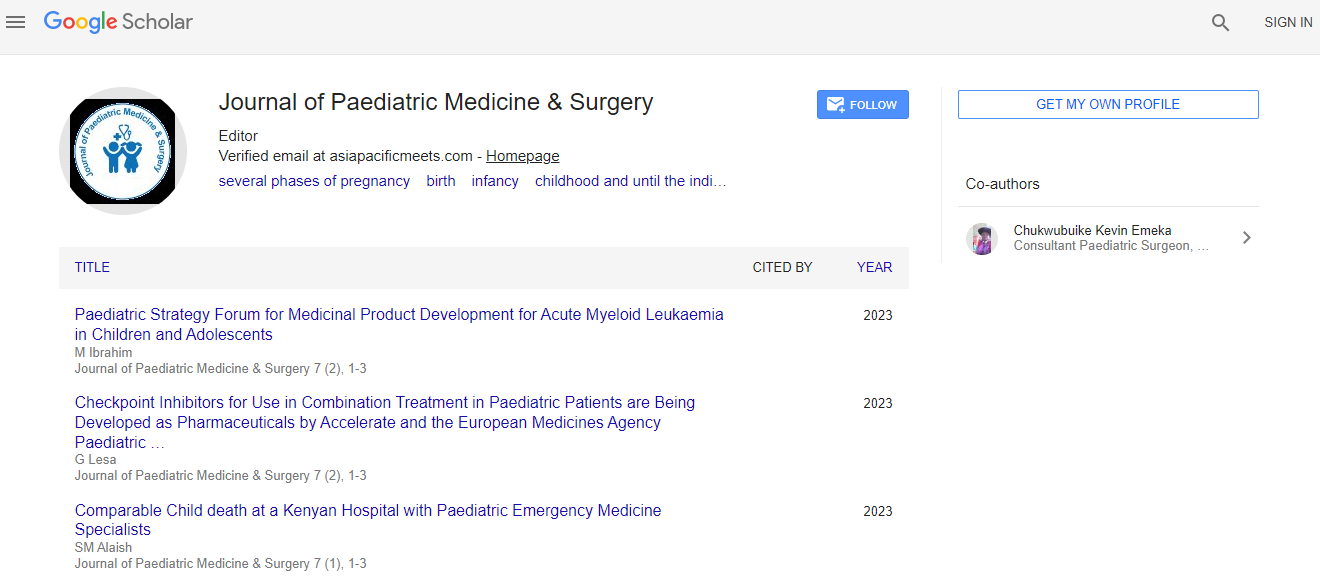Pediatric Surger & Neonatology 2018: Therapeutic hypothermia for perinatal asphyxia at a tertiary care neonatal unit in South India: Our center experience - Mehta Multispecialty Hospital
*Corresponding Author:
Copyright: © 2018 . This is an open-access article distributed under the terms of the Creative Commons Attribution License, which permits unrestricted use, distribution, and reproduction in any medium, provided the original author and source are credited.
Abstract
Objective: To study the outcomes after starting therapeutic hypothermia in our unit.
Primary Outcomes: Mortality in Neonatal Intensive Care Unit, neurological examination at discharge, seizures, encephalopathy duration, and mortality up to 18 months were the primary outcomes.
Secondary Outcomes: Number of anti-epileptic drugs (AED) at discharge, duration of mechanical ventilation, hospital cost, feeding patterns, duration of hospital stay, and neurodevelopmental outcome at 18 months was the secondary outcomes.
Setting: The study was conducted at the NICU, Dr. Mehta's Children Hospital in Chennai.
Study Period: October 2013 to December 2015.
Conclusion: Therapeutic hypothermia resulted in better survival and neurodevelopmental outcomes though there was no significant reduction in MRI and EEG abnormalities.
Keywords: Developmental outcomes, perinatal asphyxia, therapeutic hypothermia
Introduction:
Birth asphyxia contributes to 20% of the neonatal deaths in India as per Leu et al. Lancet 2012 report. Therapeutic hypothermia has been accepted as the standard of care for moderate to severe hypoxic-ischemic encephalopathy. However, therapeutic hypothermia has many limitations, especially in resource-limited settings and low, middle-income countries. We present our center experience in using therapeutic hypothermia for asphyxiated babies over a period of 2 years and 2 months (October 2013-December 2015). Our Neonatal Intensive Care Unit (NICU) is a level III unit catering for babies born in the hospital as well as for babies born outside.
Subject and Methods:
This study focuses on the short- and long-term outcomes of therapeutic hypothermia. Babies who met TOBY criteria were cooled to 33.5°C using second-generation Tecotherm within 6 h of birth for 72 h, followed by rewarming at 0.5°C/h. All the babies who were cooled at our unit were enrolled into this descriptive study after consent. We recorded the baseline maternal and neonatal characteristics. Primary outcomes studied were mortality in NICU, neurological examination at discharge, seizures, encephalopathy duration, and mortality up to 18 months. The secondary outcomes studied were number of AED at discharge, duration of mechanical ventilation, hospital cost, feeding patterns, duration of hospital stay, and neurodevelopmental outcome at 18 months. We also studied the adverse events noted before and after hypothermia. The magnetic resonance imaging (MRI) and electroencephalogram (EEG) changes were also recorded. Encephalopathy staging was done using Sarnat and Thompson score. Neurological examination at discharge was done using Hammersmith. Subsequent neurodevelopmental follow-up at 18 months was performed on the babies using Developmental Assessment Scales for Indian Infants-II.
Results:
A total of 17 babies received cooling therapy. Inborn: outborn ratio was 1:16. Male: female ratio was 10:7. Out of the 17, 4 (23.5%) were born of normal vaginal delivery, 2 (11.8%) by assisted vaginal delivery, and 11 (64.7%) of lower segment cesarean section. Fourteen babies had moderate encephalopathy and three babies had severe encephalopathy at the time of starting cooling. Mean APGAR at 10 min, pH within 60 min of life, and base excess were 5.76, 7.257, and 12.187, respectively. Mean hour of cooling from birth was 3.36 h. Mean maternal age of all the cooled babies was 26.07 years. Mean Thompson score on day 1, day 2, and day 3 of cooling was 10.5, 6, and 5.71, respectively. 2/17 babies were taken against medical advice. 4/17 babies did not complete 18 months follow-up. Our follow-up rate was 91.66%. No babies died in the NICU. 2/17 (11.8%) died after discharge. 5/16 (31%) had abnormal neurological examination at discharge. Average number of seizures was 2.07. Mean duration of encephalopathy was 5 days. Average number of AED at discharge was 0.5. Mean duration of mechanical ventilation was 2.25 days. Average number of days of starting enteral feeds was 4.92 days. Mean duration of tube feeding was 4.2 days. 12/15 (80%) were on direct breast/paladai feeds and 3/15 (20%) required tube feeding at discharge. Mean duration of hospital stay was 11.5 days. Average hospital cost per baby was Rs. 183,394. 5/11 (45.45%) had both motor and mental quotients below 85%. Adverse events noted were coagulopathy 8/16 (50%), hypocalcemia 8/16 (50%), hypomagnesemia 8/16 (50%), and shock 6/16 (37.5%). 5/15 (33.3%) and 13/16 (81.3%) had abnormal EEG and MRI, respectively. 6/17 (35.29%) had abnormal liver function tests
Discussion:
Therapeutic hypothermia has been proven as standard of care in perinatal asphyxia in developed countries. However, in resource-limited settings and low, middle-income countries, the results from the developed world cannot be extrapolated due to various practical difficulties though they contribute to many asphyxiated babies.There is also a lack of enough studies which are adequately powered from developing countries which can prove that cooling is the standard of care. We aimed to study our unit outcomes after introduction of therapeutic hypothermia. We acknowledge that our sample is too small to draw any conclusion. We just present our experience in the past 2 years and 2 months. We noticed that cooling benefited in terms of mortality and neurodevelopmental outcomes in our babies. Practical problems faced by us were high hospital cost and requirement of trained staff round the clock. We also noticed that cooling did not cause any decrease in the number of abnormal MRI and EEG. Hence, it may be noted that additional neuroprotection may be needed along with hypothermia.
Conclusion:
Therapeutic hypothermia resulted in better survival and neurodevelopmental outcomes at 18 months in our study though there was no significant reduction in mri and EEG abnormalities.

